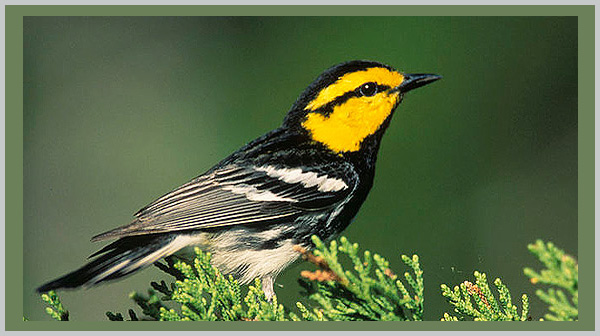
Golden-cheeked Warbler
Name: Golden-cheeked Warbler (Setophaga chrysoparia)
Conservation Status: Endangered (2021 IUCN Red List)
Wild Population Estimate: 27,000
Range: Brazil
Threats: Development / Transportation / Agriculture / Logging / Invasive Species
The golden-cheeked warbler is one of over 200 species of migratory birds whose survival is threatened by destruction of tropical rain forests. Neotropical migratory birds, including other kinds of warblers, orioles, tanagers, hummingbirds, vireos, flycatchers, whip-poor-wills, and many others, spend summers in North America and winters in the forests of South or Central America.
Each species occupies a special niche in both summer and winter habitat and is vulnerable to natural or human-caused changes. Golden-cheeked warblers are doubly threatened; in addition to losing their tropical forest habitat, they are losing their summer habitat in Texas to agriculture and development.
The golden-cheeked warbler is a small (4 to 5 inch-long or 10 to 25 cm-long) songbird that is black, white, and gray, with bright golden “cheeks” and a black eye streak. It breeds in Texas during the summer and winters in southernmost Mexico, Guatemala, Honduras, and Nicaragua.
The warbler’s population has fluctuated dramatically in the last 20 years. In 1974, the population was estimated at 15,000 to 17,000 birds. In 1990, it had dropped to 2,200 to 4,600. The warbler is listed as endangered under the Endangered Species Act (ESA) in the United States. In 2019 the U.S. Fish and Wildlife estimated around 27,000 remained in the wild.
Listing the species has led to controversy because landowners may be restricted in developing their property if it contains warbler habitat. In response to landowner complaints, one of Texas’ senators succeeded in placing a moratorium on new listings under the ESA in 1995 and 1996.
The golden-cheeked warbler is an insect-eating bird that is totally dependent on stands of mature ashe juniper in Texas for nesting habitat. Warblers arrive at their breeding grounds mid-March, returning to the same territories each year and nesting from April to May. They migrate through a narrow band of cloud forest along the eastern slope of the Sierra Madre Oriental mountain range in Mexico.
Causes of Endangerment
Habitat Destruction
The major threat to the warbler is habitat destruction and fragmentation. It shares the plight of other animals dependent on tropical rain forests, which are being cut down at a rapid pace for agriculture and human settlement.
But the most significant cause of warbler decline is the widespread destruction of juniper in Texas. From the 1950s to 1970, 50 percent of juniper habitat was cleared for pasture and urbanization.
Brown-headed cowbird parasitism is an increasing threat as habitat becomes more fragmented. Cowbirds do not live in forest, but as more forest is cleared, forest birds like the warbler must nest closer to the edge of the forest and the cowbird has ready access to their nests. The cowbird lays her eggs in the warbler’s nest, replacing the warbler’s eggs with her own. The warbler raises the cowbird chicks and thus fails to reproduce.
Pollution
Pesticide spraying to control the Mediterranean fruit fly in Guatemala affected many species of insects in addition to the fruit fly. This practice decreased the warbler’s food source.
Conservation Actions
Protection Under the Endangered Species Act
In the United States, it is illegal to “take” (kill, capture, wound, harass, or harm) a species that is on the Endangered Species Act’s list of threatened or endangered species. Harm to the species includes destroying habitat if doing so kills or injures members of the species.
Landowners who want to bulldoze warbler habitat on their land have to get permission from the government. To get permission, they must prepare a plan to help conserve the warbler on their property even though they are cutting down some of the habitat.
Better Agricultural Practices That Preserve Tropical Forest
Many songbirds that depend on tropical forest habitat could be helped by different agricultural practices. For example, large amount of tropical forest recently has been cut down to make way for sun-grown coffee plantations. In its native state, coffee grows in the shade of a varied canopy of tall trees.
Until recently, nearly all commercial coffee has been produced in conditions mimicking natural forest, with canopy trees providing fruit and firewood to the coffee farmers.
New coffee-growing methods result in these tree canopies being destroyed, and with them, habitat for songbirds. Big coffee growers now grow coffee in full sun because it yields more beans. “Sun coffee” requires heavy doses of pesticides, however. Small farmers cannot afford the increased cost of chemicals, so many go out of business.
Around twenty-five percent of the world’s coffee is consumed in the United States. If American consumers and businesses would demand shade-grown coffee, it would help preserve both habitat for songbirds and a way of life for local farmers.
For example, Starbuck’s Coffee Company, based in Seattle, Washington, has drafted a Coffee Mission that includes promoting sound environmental practices for producing and processing coffee. If this mission were to include buying shade-grown coffee beans, it could help preserve songbird habitat.
Questions for Thought
Do you think the government should have to pay landowners for their lost profits if they are restricted in developing their property in order to save endangered species? What would this practice imply about individual responsibility to conserve nature? What effect would this have on taxes?
Do you think Americans have a right to urge other countries to preserve their forests if we continue to cut down our own native forests?
Explore:
Related Classroom Activities:
[CS1-3,CS1-6,CS2-2, General]
Click here for Endangered Species Classroom Glossary